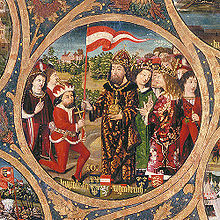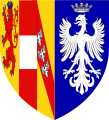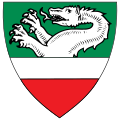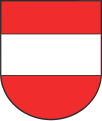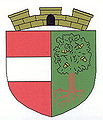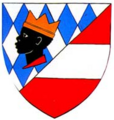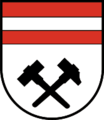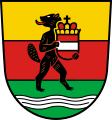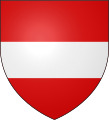Binding shield
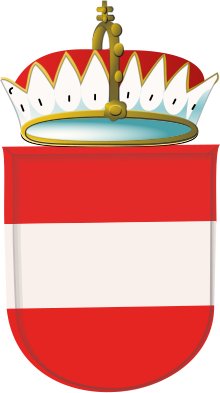
hat Privilegium maius . Title page of the copy made for Emperor Maximilian I , 1512
The shield , the silver band (bar) on a red field , is originally the coat of arms of the Babenbergs . The colors of the Habsburgs and Austria are derived from it, and it is also included in numerous other coats of arms.
For naming
In heraldry (heraldry) and vexillology (flagship) one speaks of “binding shield” only in relation to this historical symbol: The current bar was originally a narrower band . The strictly even threefolding then appears from the High Middle Ages and its formalized heraldry. Notes on choosing a name are also available here .
The colors are also called red-white-red , a tricolor that can also be found in other national flags.
history
Origin of red-white-red
There were various theses about the creation of the red-white-red family coat of arms ( house coat of arms ) of the Babenbergs . The thesis of the historian Hermann Wiesflecker that is valid today according to the latest research is that according to which the binding shield originally goes back to the red-white-red fiefdom flag of the Eppensteiners , because when this family died out in 1122, it inherited its own property and Friulian fiefdoms including its fiefdom flag to the Styrian Traungauers , and when they died out around 1138, they passed it on to their closest relatives, the Styrian Otakare , who in turn passed it on to the Austrian Babenbergs, dukes of Austria, when they died out in 1192. So the Bindenschild came from the Duchy of Swabia via Carinthia to Friuli and from there with the legacy of the Eppensteiner and Otakare von Cordenons - Pordenone via Styria to Austria. There were also the following theses in history:
- The best-known legend is that the binding shield was created during the siege of Akkon (1189–1191) in the Third Crusade, in which the Babenberg Duke Leopold V , the Virtuous (1157–1194) - not necessarily enthusiastically - participated. It is said that after the battle his white robe was soaked in blood, except for a white stripe (the "bandage") where he wore the sword belt. Henry VI. is said to have given him the coat of arms in 1191 to perpetuate his heroism . The robe is said to have been kept until the 16th century, first in Maria Enzersdorf, then in Perchtoldsdorf, and only disappeared around 1683 during the second Turkish siege .
- The story can already be found in a document around 1260, then in the chronicle of the 95 lords of Leopold Stainreuter, chaplain Albrecht III. around 1394, and is also shown in the Babenberger family tree (around 1490). These old sources are now considered unreliable and are likely to be politically motivated. Their prominence was also strengthened by the imperial patent of August 6, 1806, in which the new coat of arms of the Austro-Hungarian monarchy was established and this legend is explicitly referred to.
- Duke Frederick II., The pugnacious (1211-1246) was after a dispute with his Siegelverwahrern, the Kuenringern can manufacture that it did not want to give out a new, distinctive seal.
- The version goes back to Chrysostomus Hanthaler , the prior of the Lilienfeld monastery and dates back to the middle of the 18th century.
- The red-white-red comes from the Counts of Poigen-Hohenburg- Wildberg ( Poigen in the Lower Austrian district of Horn ). The Babenbergs would have taken it - before 1210 - from these, after their extinction, together with their fiefs.
- Karl Lechner, former regional historian of Lower Austria is considered to be the originator of this hypothesis.
- The binding shield could have been a Babenberg symbol even earlier. On a pen drawing of the Battle of the Rain in 1105, Leopold III the Saint (1073–1136) is depicted with a three-part shield.
- This version comes from Andreas Kusternig (Lower Austria State Government, Department of Culture and Science). The colors of the coat of arms are not shown. The depiction of Leopold in the window of the fountain house in Heiligenkreuz dates from around 1290 and is a later, Habsburg attribution.
However this coat of arms was created, from the middle of the 13th century the Babenbergers used the silver bar on a red background as a family coat of arms, and only this is referred to in heraldry as a binding shield .
- The earliest source is an official wax seal on a document dated November 30, 1230, which confirms the privileges of the Lilienfeld Monastery. It is damaged and shows no color. A triangular rider's shield is shown. A better preserved seal dates from 1236 (Stiftsarchiv von Heiligenkreuz ).
- The colors are confirmed in contemporary reports of Friedrich II's sword guiding on February 2, 1232 in red-white-red festive clothing in the Schottenkloster in Vienna . (Bishop Gebhard von Passau , 1232, Fürstenbuch des Jans der Enikel , around 1280).
The choice of color - this is perhaps a true core of the Acre legend - is likely to be related to the old imperial storm flag of the Holy Roman Empire for the Crusades , the silver cross on a red background. Its colors were very popular at the time when European heraldry was flourishing. In 1237 the city of Vienna also received this symbol as a coat of arms, and continues to use it today. But a connection with the city colors of Regensburg (two silver keys on red) is suspected - Heinrich II. Jasomirgott , the first Dux Austriae (Duke) had moved his residence from Regensburg to Vienna in 1145.
From Babenberg to Austria
Originally a Babenberg symbol, the colors soon became the territorial symbol of the Babenbergs' possessions in the Marcha orientalis , the market in eastern Baiern (Ostmark), in the area of Lower Austria - at that time still including today's Upper Austria , the name of which is contemporary for the county of Tyrol and Vorarlberg.
The seal of Ottokar II Přemysl (around 1232–1278), Duke of Austria from 1251, shows the shield of the binding. The seal of Count Otto von Plain and Hardeck is dated 1254, also with the same badge - it also shows the helmet ornament made of peacock feathers, the peacock bump, whose origin is unclear, while Ottokar Přemysl leads the Bohemian eagle flight .
In 1340, recorded in the Zurich coat of arms , Austria in Babenberg already had the shield under the Pfauenstoss.
For unknown reasons, the Bindenschild, as New Austria, also replaced the Lark coat of arms with the five eagles ("Lerchen"), which was then called Old Austria , as the coat of arms of the Habsburg hereditary lands from the 15th century .
From Austria to Habsburg
The house coat of arms of the Babenbergs was also used by the Habsburgs as their house coat of arms after they were enfeoffed with the lands of the Babenbergs. This is likely to go back to Rudolf von Habsburg , the first Roman-German king from the House of Habsburg, who enfeoffed his sons Albrecht and Rudolf with the duchies of Austria , Styria , Krain and the Windischen Mark in 1282 , and with the Rheinfeld house rules the basis for the Habsburg power in Austria and the later hereditary lands . In doing so, the Habsburgs - coming from today's Switzerland - were probably very well aware that they were perceived as foreign rule, and tried expressly to tie in with the Babenberg history (for example, from the Babenberg family burial in Heiligenkreuz Abbey around 1290 to the Babenberger family tree around 1490 ). As a result, Habsburg also called itself House of Austria .
In 1325 Frederick the Fair (1314–1330) placed the shield on the chest of the royal eagle, creating the ancestral form of today's Austrian coat of arms.
use
- Using the binding shield on coins:
The red-white-red shield was not only used by the Babenbergers and Habsburgs and their branches as coats of arms, but also by many communities, towns and districts of the Habsburg Empire to symbolize their affiliation. Several municipalities in Austria, Germany (especially in Upper Austria ) and even in Belgium (former Austrian Netherlands) continue to use the binding shield as their official coat of arms.
In 1816, King Maximilian I Joseph of Bavaria raised the Pausinger family to the nobility and gave them a red, white and red shield as a coat of arms. When Felix von Pausinger (1824-1893) asked for the recognition of his Bavarian nobility in Austria, the Imperial and Royal Interior Ministry insisted on changing the Pausinger family coat of arms and only accepted it after the shield was no longer recognizable as such due to a change in the coat of arms in 1857.
The shield can be found on the chest of the Austrian federal eagle , in the regional coat of arms of Carinthia (already from the Babenberger time), in the large coat of arms of Baden-Württemberg (above Austria) and in the arms of the Belgian provinces of Flemish Brabant and Liège (via the Austrian Netherlands). The coat of arms of the Prince Archbishopric of Salzburg should also be mentioned.
- Dynastic use:
Coat of arms of those of Habsburg-Lothringen
from Austria-Tuscany
from Austria-Este
- Use during the imperial era:
Small coat of arms of Austria-Hungary (1916)
Trieste (until 1918)
- Usage today in Austria:
Flag of Austria :
here federal service flag and military flag
(the federal coat of arms on the silver band) ; also: national flag and sea flag (without eagle)State coat of arms of Carinthia
(in the left split )
- Other coats of arms, Austria:
Baden (Lower Austria) with bathers
Dornbirn , Vorarlberg (as a commitment of the city to the Habsburgs and a clear demarcation from the neighboring Hohenems counts )
Enns , Upper Austria (Combination of Styrian Panther and Bindenschild ( Georgenberger Handfeste ))
Freistadt , Upper Austria
Hallstatt , Upper Austria
Imst , Tyrol
Kefermarkt , Upper Austria
Laa an der Thaya , Lower Austria
Laxenburg , Lower Austria
Linz , Upper Austria
Linz coat of arms until 1965
Mödling , Lower Austria
Neuhofen an der Ybbs , Lower Austria
Neustift im Stubaital , Tyrol
Ostermiething , Upper Austria ( Rauten: bond with Bavaria )
Perchtoldsdorf , Lower Austria
Reutte , Tyrol
Schörfling am Attersee , Upper Austria
Schwaz , Tyrol
Seeham , Salzburg
Stockerau , Lower Austria
Tulln (shows the original rider's shield with a pronounced band, next to it the imperial banner )
Vöcklabruck , Upper Austria Red-white-red binding shields (nine in total) and two flags
Wels , Upper Austria
Wiener Neustadt , Lower Austria
- Other coats of arms, South Tyrol:
- Other coats of arms, Germany and Switzerland (formerly front Austria ) (detailed list: front Austria # historical significance )
The coat of arms of Vorderösterreich is the last of the six small coats of arms on the top left of the large coat of arms of Baden-Württemberg
Buchenbach , Breisgau-Hochschwarzwald - with a wavy band
Günzburg , Bavaria
(until 1812)Zofingen , Aargau
- Other coats of arms, Belgium and Luxembourg (former Austrian Netherlands ):
- Other coats of arms, Alsace ( under the Habsburgs ):
- Other coats of arms, Czech Republic:
- Other coats of arms, Latvia:
literature
- Federal Ministry of the Interior: The symbols of the republic. In: Public Safety 11–12 / 06, pp. 69–75.
- The symbols of the republic . In: Federal Ministry of the Interior (Ed.): Public Security . No. 11-12 . Kremayr & Scheriau, 2006, p. 69–75 ( ( page no longer available , search in web archives: PDF ) [accessed October 24, 2017] no mementos).
- Peter Diem: The symbols of Austria. Time and history in signs. Kremayr & Scheriau, Vienna 1995, ISBN 3-218-00594-9 .
- Andreas Kusternig: eagles and red-white-red - symbols from Lower Austria. Exhibition of the cultural department of the office of the Lower Austrian provincial government (= catalog of the Lower Austrian provincial museum. New series, volume 174). Vienna 1986, OCLC 165831821 .
Web links
- Peter Diem: The symbols of Austria and its federal states. In: peter-diem.at. 2001 .
- Entry on the binding shield in the Austria Forum (in the AEIOU Austria Lexicon )
Individual evidence
- ↑ Bindenschild Leopold III., Brunnenhaus Heiligenkreuz. In: Wikimedia Commons . The picture shows a representation of the 1290s, Heiligenkreuz , Babenbergerfenster.
-
↑ Entry on Heiligenkreuz - Cistercian monastery, fountain house with Babenberger window (1295) in the database of the state's memory of the history of the state of Lower Austria ( Museum Niederösterreich ).
Entry on Klosterneuburg Abbey, its symbolism and its treasures: The glass windows in the Austria Forum . - ↑ a b c d e f g Peter Diem: Red-White-Red through the centuries. The true story of the Austrian colors. (similar also as PDF; 1.6 MB; version dated December 1, 2008 ) In: peter-diem.at. Retrieved May 15, 2008 .
- ↑ Lit. Federal Ministry of the Interior: The symbols of the republic.
- ^ Hermann Wiesflecker: Austria in the age of Maximilian I, the unification of the countries to form an early modern state. The rise to world power. Verlag für Geschichte und Politik / Oldenbourg, Vienna / Munich 1999, ISBN 3-7028-0363-7 / ISBN 3-486-56452-8 , p. 138 f.
- ↑ Austria Lexicon. Vienna 1966, p. 978 - information after Diem, without further information.
- ↑ Lit. Kusternig: Adler und Rot-Weiß-Rot. 1986, p. 46 f.
- ^ Entry on Bindenschild in the Austria Forum (in the AEIOU Austria Lexicon ).
- ↑ See section Literature : Kusternig: Adler und Rot-Weiß-Rot. 1986 - According to Peter Diem: red-white-red through the centuries. The true story of the Austrian colors. (similar also as PDF; 1.6 MB; version dated December 1, 2008 ) In: peter-diem.at. Retrieved December 30, 2017 .
- ^ Kusternig: Adler and red-white-red. P. 50 f.
- ^ Norbert Weyss: Austria and Bindenschild. In: Adler. Journal of Genealogy and Heraldry. 1/89, p. 1 ff., With illus. (Full article pp. 1–10, 42–50, 81–91 - after Peter Diem: Red-White-Red through the Centuries. The true history of Austrian colors. (PDF, 1.6 MB; amended on 1 December 2008) In: peter-diem.at. S. 3 , accessed on 15 May 2008 . )
- ^ Regensburg annual theme 2006 - The connections: Austria. Founded in Regensburg. In: regensburg.de. City of Regensburg, archived from the original on June 29, 2007 ; accessed on October 24, 2017 (slide the horizontal bar to the right below).
- ^ Manfred Scheuch : Austria - Province, Empire, Republic. A historical atlas. Verlag Das Beste, Stuttgart / Zurich / Vienna 1994, ISBN 3-87070-588-4 , p. 16 ff .: The Empire of Premysl Ottokar II - with ill.
- ↑ Heiligenkreuz Abbey is the burial place of 4 Babenberg rulers and one blessed ( Memento from August 30, 2011 in the Internet Archive ). In: stift-heiligenkreuz.org, accessed on October 24, 2017.
- ↑ Entry on Der Babenbergerstammbaum in the Austria Forum , (an earlier version , on aeiou.iicm.tugraz.at), accessed on October 24, 2017.
